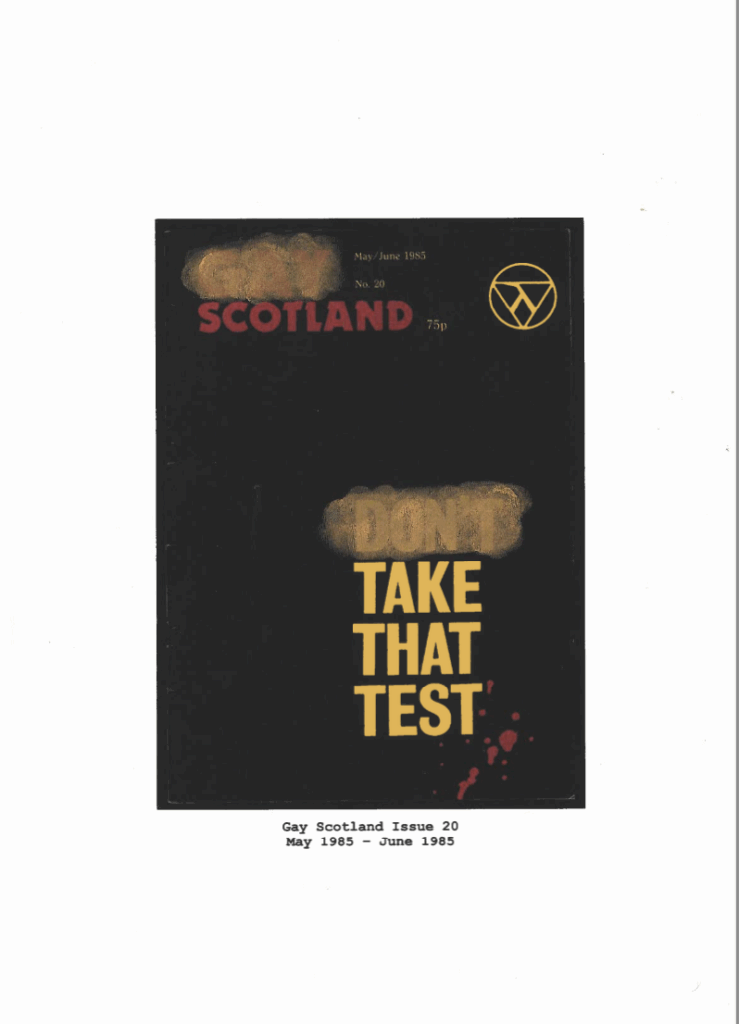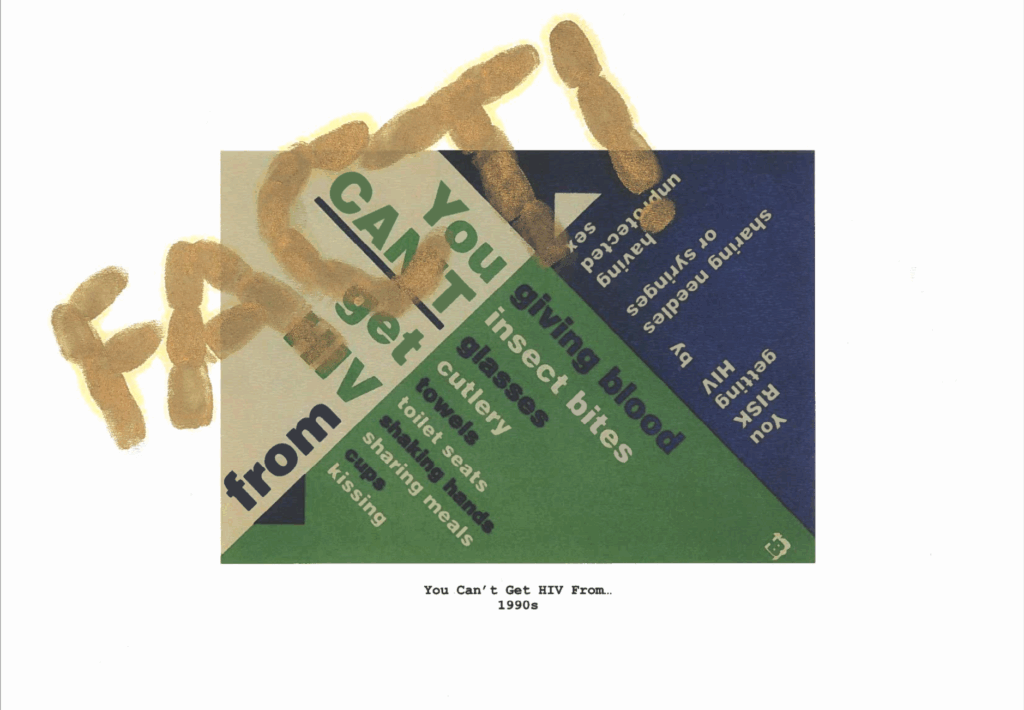This collaborative workshop took place at the University of Edinburgh in October 2024 as part of a symposium run by IReSH (Interdisciplinary Research in Sexual Health Network) and Unseen Hands. The symposium aimed to create a collaborative space for community organisations, researchers, and practitioners in the fields of sexual and reproductive health (SRH) and blood-borne viruses (BBV) to share cross-sector work being undertaken across Scotland.
The workshop featured an interactive exploration of the Lothian Health Services Archive, supported by Louise Williams, where participants engaged with the archive through tactile experience. Over the course of the afternoon, participants were encouraged to use gold ink to explore their feelings about and alter/ update HIV campaign materials from the 1980s, 1990s, and 2000s.
All images are reproduced here with the permission of the Lothian Health Services Archives and additional information about the health campaigns was provided by Louise Williams. The gallery below shows original images and altered images side by side.
Image 1: Cover of Gay Scotland 1985 (Issue 20).


Image 2: Cover of Gay Scotland 1985 (Issue 20).


Early HIV campaigns in gay publications initially encouraged people not to get tested. At the time, the lack of effective medical intervention for people living with HIV (referred to here as HTLV-3) meant that for many individuals the disadvantages of getting tested (adverse implications for insurance, negative impact on mental health, stigma, homophobia, adverse implications for safe sex) outweighed the advantages. There was also a lack of clarity about the relationship being testing positive for HIV and developing AIDS, and a lack of knowledge about HIV more generally both inside and outside the medical profession.
Image 3: SAM leaflet (1986)


SAM (Scottish AIDS Monitor) was started in 1983 by a group of men who, facilitated by the availability of affordable flights between Scotland and the US, noticed the impact that HIV was having in New York before first case of HIV was diagnosed in Scotland. The organisation started as an information charity that took information about HIV into gay clubs. They also wrote regular columns in Gay Scotland and helped to open the first purpose-built AIDS hospice in the UK in 1991. While the charity initially targeted gay men, they later went on to work with a variety of different demographics, including heterosexual people, intravenous drug users, sex workers, and prison inmates.
Image 4: AI_S: It’s not a game (1990s)


This image is taken from one of a number of postcards held in the Lothian Health Services Archives as part of the ‘Take Care’ campaign collection. It was designed by Simon Impey and John Daniel for Hammersmith and Fulham, and is part of an aesthetic movement also seen in the infamous 1987 UK Health Departments ‘AIDS – Monolith’ TV advert and ‘Don’t Die of Ignorance’ campaign, all of which aimed to prevent the spread of HIV through disseminating fear.
Image 5: ‘Prejudice can hurt more than HIV’ (1990s)


This image comes from the ‘Take Care’ campaign and targeting the heterosexual transmission of HIV. Although there are few HIV advertisements that address the impact on HIV on children, this advert was published at a time when councils were starting to put together guidelines and educational programmes for schools. The materials aimed to combat HIV stigma by focussing on which kinds of behaviours carried a risk of contracting HIV and which did not.
Image 6: What Should a Real Scotsman Wear Under his Kilt? (1990s)


This poster was created by Aird McKinstrie and Neil Mackay at Millhouse Design created the campaign for SAM (Scottish AIDS Monitor). The model is Des Hamilton.
Image 7: AIDS Anxiety? AIDS Reassurance! (1990s)


CRUSAID was founded in 1986, and merged with the Terrence Higgins Trust in 2010. They focussed on fundraising activities as well as producing public health and poster campaigns and supporting World AIDS Day. Crusaid also supported research into treatment for HIV, and, in collaboration with the Terrence Higgins Trust (THT), they set up a hardship fund that THT continues to run. This image comes from a campaign to increase the quality of life for HIV positive adults and children, and speaks to the ethos of the charity.
Image 8: This is My Body: Arts Project Annual Report 1994/95


Waverley Care ran a series of arts projects Waverley Care ran a series of arts projects for people living with HIV, both from their drop-in centre (Solas) and Milestone House (the UK’s first purpose-built AIDS hospice). This image comes from the front cover of a report on the different initiatives run that year. The project ran different exhibitions in venues around Edinburgh showcasing photography and artwork that focussed on a range of different themes.
Image 9: ‘Take Care of the One You Love’ (1990s)


Image 10: ‘Play Safely’ (1990s)



This pamphlet was created by Manchester AIDS line (set. 1985), which later became George House Trust. The leaflet was collected as part of the Take Care campaign work. The content typifies material produced for the gay community by voluntary organisations; it uses more colloquial language and explicitly mentions how to stay safe while engaging in different sexual practices.
Image 11: ‘You Can’t Get HIV From… (1990s)


This postcard was issued by the Lothian Health Board and designed by Simon Impey and John Daniel. It focuses on decreasing HIV stigma by increasing knowledge about the ways in which HIV is transmitted and actions that carry no risk of transmitting HIV.
